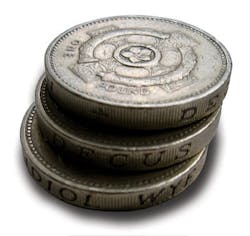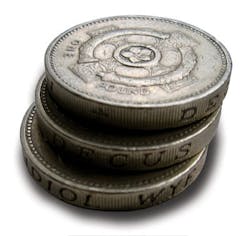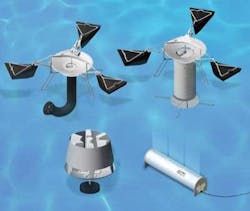Why IDA's New President is Worth His Salt
A former engineer with 20 years experience in desalination, Dr Corrado Sommariva is well placed to lead the International Desalination Association. Tom Freyberg catches up with the newly elected president to find out his aims for the association and views on new technologies and water reuse.
It's easy to see why Dr Corrado Sommariva is so enthusiastic about not only desalination, but desalination in the Middle East.
As a young, budding engineer he visited the region in 1988 for a six month period. He ended up staying for 20 years and today heads up ILF Consulting Engineers Middle East.
And with 39 million cubic metres/day of desalination capacity expected to be added in the region up until 2020, with investment of USD45-50 billion, it looks like Sommariva won't be leaving anytime soon.
Starting from a very technical background, he still to this day "remains an engineer at heart", who loves "pursuing technical excellence and innovation". It is the Middle East where Sommariva recommends any young water engineer to kick-start their career. He describes the region as a "gymnasium" which can "enrich the experience of any young engineer working in this part of the world". And from hearing about the new IDA president's fast-paced career there, it's clear to see the intellectual, technical and physical work out he got from those early years has certainly put him in good stead for his new found responsibilities.
It was during the IDA World Congress in Perth this summer where Sommariva secured presidency over Veolia Water's Michel Canet, by a mere two votes to take over as president until 2013. Teng Chye KHOO, chief executive of Singapore's PUB was also in the running so it was a strong line-up to lead the association over the next two years.
With such vast industry experience and knowledge, not to mention previous roles at the World Heath Organisation and European Desalination Society, you could assume Sommariva might have expected to be crowned the new president of the IDA, hands down. This is not the case. And a humble and grounded response indicates exactly why the new president will excel in leading desalination globally through technical and experienced diplomacy.
"First, let me say that it is a great honour to be appointed as the president of the IDA," he says. "We were blessed by having three strong candidates in the presidential election this year.
"Both Michel Canet and KHOO Teng Chye are exceptional individuals, both professionally and personally, and either would make a great president. It is always a surprise when you win against such strong candidates, and I take the trust and confidence seriously that my colleagues have placed in me."
There are so many questions to ask the new president, it's hard to know where to start. Improving costs of desalinated water; technology developments and desalination vs. water reuse to name a few. The following is an extract from a full interview with Sommariva.
Water & Wastewater International magazine (WWi): During your career to date, you must have seen - through technological advancements - the price of desalinated water decrease greatly over the years. Where do you see this going and how will prices become more competitive?
Dr Corrado Sommariva (CS): It is true that the price of desalinated water has decreased a great deal. This has been largely due to improvements in technology. While energy consumption accounts for a large portion of operating expenses, the price of a desalination project is still strongly governed by the price of raw materials.
For example, in 2004 when the price of nickel and copper were at their bottom, peak MSF (Multi-Stage Flash) technology went down in price to US$4.5/IGD (imperial gallons per day) installed. A few years later, when copper price jumped to US$10,000 per metric ton, the project costs increased dramatically to an average of US$ 8-10/IGD. While thermal desalination is greatly dependent on this, SWRO (seawater reverse osmosis) is less sensitive. Membrane costs are getting lower and increasing performance allows for further reduction in costs. On the other hand, a lot of components in a SWRO project are still strongly dependent on material cost fluctuations.
WWi: On the subject of membranes, RO is starting to take over from many thermal processes in the Middle East. What role do you see forward osmosis playing, especially after Modern Water proved its Manipulated Osmosis technology in the Omani trial?
CS: I was very impressed reading about the development in Oman and look forward to seeing the outcome of the project. While perhaps this is the solution for the foreseeable future, I would like to emphasise that we need to continue technological development and the implementation of best practices designed to enhance energy efficiency. This applies to both new and existing plants. As new technologies are being developed, there is much we can do to upgrade and optimise units now in operation. This applies to all technologies, both thermal and RO.
IDA has been invited by the Tianjin government to host the 2013 Congress in China
WWi: A recent Global Desalination Report predicted that by 2015 desalination could rival water reuse costs. This will be through energy recovery systems fitted to RO plants, and energy saving feed water intake systems. Thoughts?
CS: I am not sure that I agree with this. While energy comprises the largest item in operating costs, CAPEX is still the greatest overall cost item. In many cases, the cost of desalination is already rivaling water reuse costs.
Improving energy consumption is essential to face the issues related to sustainability but I do not expect to have a great impact on tariff for the time being – particularly in the Middle East where the price of energy is still very low (US$ 1/MBTU).
With such a low price, the installation of more sophisticated energy recovery devices is often not commercially attractive, and the higher CAPEX spent to invest in more enhanced energy recovery devices are not recoverable by the energy savings that are achieved in the plant lifetime.
Here I believe IDA can play a role in encouraging policies that encourage energy savings and the correct application of energy tariff in desalination technology. In this manner, contractors and developers would be incentivised to develop more sustainable solutions.
WWi: Recent statistics from the IDA World Congress cite Saudi Arabia as being the largest desalination market, followed by the UAE, Spain and the United States. China is not mentioned in the top four, yet the IDA will be holding its Word Congress there in 2013. Apart from industrial uses, how do you expect desalination to play a larger role for municipal water in China?
CS: China has already developed several desalination projects and water is an important issue in such an expanding economy. IDA was invited by Tianjin government to host the World Congress there as a way to support the development of the industry and of the technology in the region. To this extent I believe that the choice of China is most appropriate.
Forty years ago, desalination was a technology primarily used in the Middle East. Now it has become a technology that has been widely adopted in areas outside the original traditional nucleus of the Middle East and has expanded widely so that it is practiced today in 150 countries.
"Improving energy consumption is essential to face the issues related to sustainability but I do not expect to have a great impact on tariff for the time being, particularly in the Middle East where the price of
energy is still very low"
WWi: What state of play do you predict the desalination industry will be in 10 years from now, and what do you think will be the biggest technical challenges facing the industry then?
CS: Desalination projects are large assets requiring large capital investment. While the need for constructing new desalination plants remains, banks' appetite to finance IWPs (Independent Water Project) has certainly decreased. Several projects have been postponed or shelved because of this. The public sector has taken over again from the private sector in many areas, and this would imply a more conservative approach towards risk and innovation. However, I believe that soon it will be clear that investing in desalination generally represents a minor risk, and all forecasts point to reinvigoration of the market.
WWi: And finally, what do you hope to achieve during your term as IDA president?
CS: My vision is to contribute to the positive development of the desalination industry and hence contribute to the development of society and of the environment in which we all live and operate. Of course, this means continued efforts to encourage technological innovation and strive to further enhance energy efficiency and environmental stewardship.
What I can practically try to achieve during my term is to continue to advance some important initiatives that we have undertaken, such as the Young Leaders Programme, our Environmental Task Force and the humanitarian initiative. The humanitarian initiative is one that I personally support and encourage. In this regard, I would like to see IDA continue the work begun earlier this year at our "Desalination Industry Action for Good" conference that focused on the relationship between desalination and social responsibility.
Desalination is the key to providing fresh water to many people now thirsting for a solution. I would encourage our industry to continue developing new models for sustainability and affordability, and formalising a resource to be used in the event of natural disasters and other humanitarian crises around the world. This is the goal of IDA's recently formed Humanitarian Outreach Committee.
Innovation needs to be further encouraged and rewarded, particularly with regard to sustainability and renewable energy solutions. An example comes from the power sector. Ten years ago, nobody would have believed in renewable power generation, yet today, power generation in several countries is greatly supported by renewable solutions.
I hope IDA can play a stronger role in the development of more innovative solutions that could bring us to a similar scenario. The resulting technology can follow the power sector's model if the policy makers, lenders and public corporation find the correct mechanism to encourage this development.
WWi: I read that you regularly conduct courses on desalination and water reuse and hold courses at the Bushnak Academy in Dubai. How will you be promoting training at the IDA?
CS: Training is also an area where I believe there is a lot of work we can do. Within IDA, we have some of the most reputable experts and lecturers for all disciplines. Training is one of the main objectives of IDA's Constitution, and IDA is committed to implementing a training program. It is in one of the main objectives of my mandate to develop and a more comprehensive training program that could possibly be combined with affiliates (such as the European Desalination Society) or strategic partners and eventually developed into an IDA Desalination Academy. This would offer also a good opportunity also to tighten bonds and improve cooperation. We are currently exploring how this will work.
Perhaps most importantly, I believe that there is a great opportunity to further strengthen ties between IDA and the many stakeholders in the desalination community. For example, I believe that there are still too many players in the industry who are not yet aware of what desalination could achieve. These same players are also not enough aware of what IDA can offer – particularly public institutions and end users that are key figures in the planning and decision making of desalination projects. I believe that greater involvement with IDA would lead to their making more informed decisions during the initiation of their projects. WWi
Author's note: Tom Freyberg is the chief editor of WWi magazine. Email: [email protected].
Career highlights: Dr Corrado Sommariva
- Currently managing director of ILF Consulting Engineers Middle East, having joined the company in 2009
- From 2000 to 2009 he led the desalination and water treatment group as managing director of Generation Middle East at Mott MacDonald
- President of European Desalination Society (EDS) 2004-2005 and on Board of Directors for the last 14 years
- Former chairman of the World Health Organisation (WHO) committee for the establishment of safe drinking water from desalination
- PhD in Chemical Engineering from Genoa University
- Diploma in Management from Leicester University.
More Water & WasteWater International Current Issue Articles
More Water & WasteWater International Archives Issue Articles


